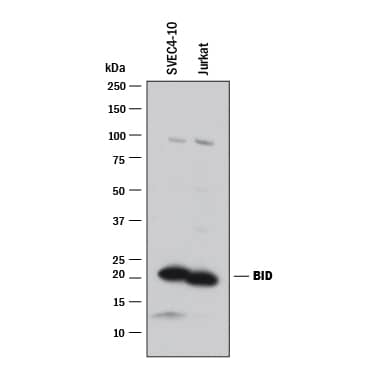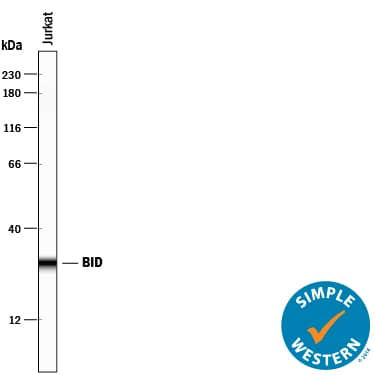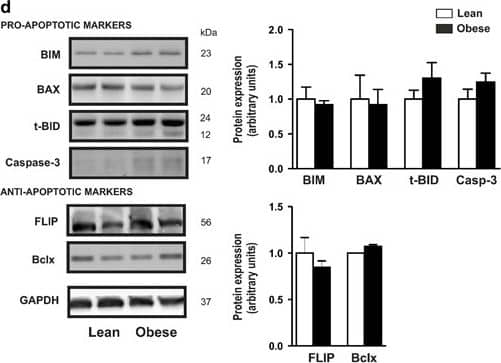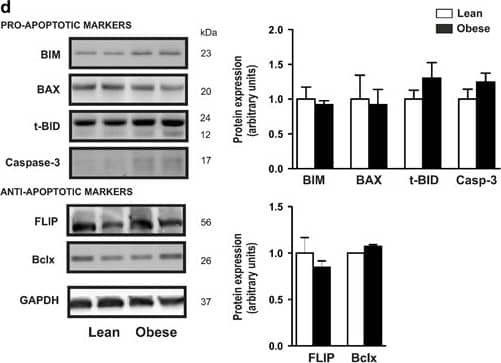Human/Mouse BID Antibody
R&D Systems, part of Bio-Techne | Catalog # AF860

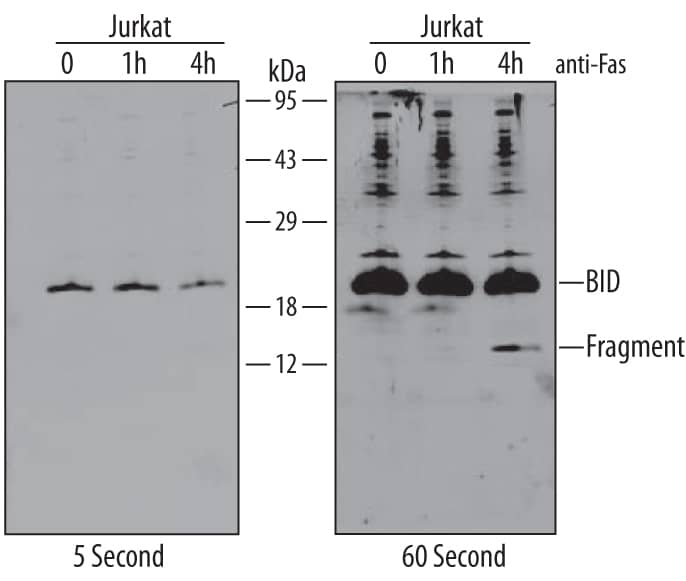
Key Product Details
Validated by
Species Reactivity
Validated:
Cited:
Applications
Validated:
Cited:
Label
Antibody Source
Product Specifications
Immunogen
Met1-Asp195
Accession # AAC71064
Specificity
Clonality
Host
Isotype
Scientific Data Images for Human/Mouse BID Antibody
Detection of Human BID by Western Blot.
Western blot shows Jurkat human acute T cell leukemia cell line treated with apoptosis inducer anti-Fas for the indicated times. PVDF membrane was probed with 1 µg/mL Goat Anti-Human/Mouse BID Antigen Affinity-purified Polyclonal Antibody (Catalog # AF860) followed by HRP-conjugated Anti-Goat IgG Secondary Antibody (Catalog # HAF109). A specific band was detected for BID at approximately 20 kDa (as indicated). For additional reference short (5 seconds, left panel) and long (60 seconds, right panel) exposures are shown. This experiment was conducted under reducing conditions and using Immunoblot Buffer Group 2.Detection of Human and Mouse BID by Western Blot.
Western blot shows lysates of SVEC4-10 mouse vascular endothelial cell line and Jurkat human acute T cell leukemia cell line. PVDF membrane was probed with 1 µg/mL of Goat Anti-Human/Mouse BID Antigen Affinity-purified Polyclonal Antibody (Catalog # AF860) followed by HRP-conjugated Anti-Goat IgG Secondary Antibody (Catalog # HAF017). A specific band was detected for BID at approximately 20 kDa (as indicated). This experiment was conducted under reducing conditions and using Immunoblot Buffer Group 1.Detection of Human BID by Simple WesternTM.
Simple Western lane view shows lysates of Jurkat human acute T cell leukemia cell line, loaded at 0.2 mg/mL. A specific band was detected for BID at approximately 29 kDa (as indicated) using 10 µg/mL of Goat Anti-Human/Mouse BID Antigen Affinity-purified Polyclonal Antibody (Catalog # AF860) followed by 1:50 dilution of HRP-conjugated Anti-Goat IgG Secondary Antibody (Catalog # HAF109). This experiment was conducted under reducing conditions and using the 12-230 kDa separation system.Applications for Human/Mouse BID Antibody
Immunoprecipitation
Sample: Jurkat human acute T cell leukemia cell line treated with anti-Fas, see our available Western blot detection antibodies
Simple Western
Sample: Jurkat human acute T cell leukemia cell line
Western Blot
Sample: Jurkat human acute T cell leukemia cell line was treated or untreated with anti-Fas and SVEC4‑10 mouse vascular endothelial cell line
Reviewed Applications
Read 4 reviews rated 4 using AF860 in the following applications:
Formulation, Preparation, and Storage
Purification
Reconstitution
Formulation
Shipping
Stability & Storage
- 12 months from date of receipt, -20 to -70 °C as supplied.
- 1 month, 2 to 8 °C under sterile conditions after reconstitution.
- 6 months, -20 to -70 °C under sterile conditions after reconstitution.
Background: BID
BID is a 195 amino acid member of the Bcl-2 family of proteins that regulates outer mitochondrial membrane permeability (1). BID is a pro-apoptotic member that causes cytochrome c to be released from the mitochondria intermembrane space into the cytosol. In healthy cells BID is cytosolic. In response to Fas ligand or TNF, BID is cleaved by caspase-8 and it then relocates to the mitochondria outer membrane (2, 3). Cleavage of BID by caspase-8 generates a new N-terminal that contains a terminal glycine. It appears that the glycine is myristoylated and myristoylation serves to target BID to the mitochondria (4). BID may then interact with another pro-apoptotic Bcl-2 family member Bak (5). Interaction of BID with Bak causes altered mitochondrial membrane permeability. A 9‑13 amino acid stretch called the BH3 region (Bcl-2 homology region) appears to mediate the BID interaction with other Bcl-2 family members. BID is neutralized by binding to the anti-apoptotic member Bcl-xL.
References
- Gross, A. et al. (1999) Genes and Develop. 13:1899.
- Luo, X., et al. (1998) Cell 94:481.
- Li, H. et al. (1998) Cell 94:491.
- Zha, J. et al. (2000) Science 290:1761.
- Wei, M.C. et al. (2000) Genes Dev. 14:2060.
Long Name
Alternate Names
Gene Symbol
UniProt
Additional BID Products
Product Documents for Human/Mouse BID Antibody
Product Specific Notices for Human/Mouse BID Antibody
For research use only
